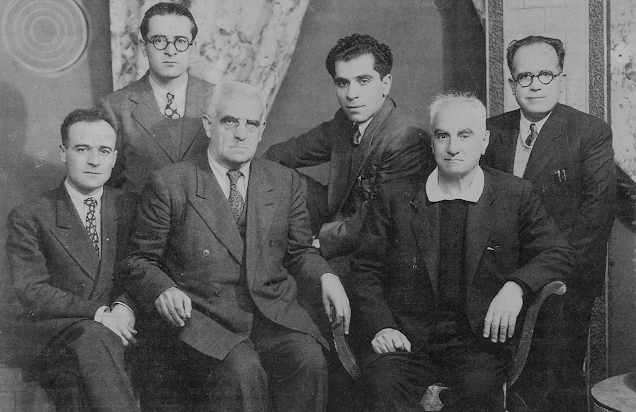Vahe H. Apelian
 |
| "The Greats and the Others" by Antranig Zarougian |
“They Were, (and) are no more” (Կային Չկան) is the title of the last chapter of Antranig Zarougian’s “The Greats and the Others” (Մեծերը եւ Միւսները) book.
The book was published in 1992, at least that is the publication date indicated in my copy of the book. I have read Antranig Zarougian’s books, but this book I have read more than once. In seven chapters Zarougian depicts his perception of those he considered greats and not so greats, but non-less, devoted to Armenian culture and cause. The last, and the eight chapter, is devoted to the “others”.
The book is 351 pages long and was printed in Antelias, ostensibly by the Catholicosate of Cilicia printing office. Mr. Kegham Ohanian had undertaken the printing expenses in memory of his wife.
Zarougian made the following comment at the very beginning of the text, which I believe encapsulates a state of Diasporan life, he perceived to be starkly true. I quote, “Diaspora, is an unsettled and a fluid state, where the real greats cannot succeed remaining great and those who are gifted for greatness, have no room to become great”.
In a superb narration, characteristic of Antranig Zarougian’s writing, he reminisced about those he considered were greats. But, at the same time, palpable in his opening remarks, there seemed to permeate a pessimistic undertone that those whom he considered to have been great, have faults of their own, having personally known them and dealt with them.
The quote might also be a reflection of Zarougian’s frustration. Zarougian was cognizant of his genius and might have expected that he should have had a more prominent standing in the Armenian Diaspora as a whole. Let us be mindful that the book was written twenty-eight years ago and there was a time when a segment of the Armenian Diaspora shunned him and his literary works and the “Nairi” Weekly he published.
 |
| Antranig Zarougian |
The personalities he presented in the book are the following:
- Levon Shant and Nigol Aghpalian. Both are depicted as his teachers in the famed Jemaran. Levon Shant, the school’s founding principal, “was an Armenian playwright, novelist, poet and founder of the Hamazkayin Armenian Educational and Cultural Society.” (Wikipeida). Nigol Aghpalian “was an Armenian public figure and historian of literature” was a teacher after having been the Minister of Public Education, of the first republic of Armenia. Both were prominent members of the Armenian Revolutionary Federation (ARF)) and were depicted in the first chapter of the book titled “The Contrasting Twins ” (Հակադիր Երկուորեակներ), pages 9 to 62. I translated an abridged version of this chapter and posted it on my blog in five installments.
- Hagop Oshagan, was an eminent writer and literary critic. The chapter is titled “Solitary Giant” (Մենակեաց Հսկան), pages 65 to 118.
- Arshag Chobanian, was a “short story writer, journalist, editor, poet, translator, literary ciritc, playright and novelist” (Wikipedia). The chapter is titled “The Patriarch of Armenian Literature” (Հայ Գրականութեան Նահապետը), pages 121 to 170.
- Arshavir Shiragian and Drasdamag Ganayan (Dro). The former, Arshavir Shiragian, “was an Armenian writer, who was noted for his assassination of Said Halim Pasha and Gemal Azmi as an act of vengeance to their roles in the Armenian Genocide” (Wikipedia). These assassinations were part of Operation Nemesis run by the Armenian Revolutionary Federation (ARF). The latter, Drastamad Ganayan, “better known as Dro, was an Armenian military commander and politician, a member of the Armenian Revolutionary Federation. He served as Defense Minister of Armenia in 1920.” (Wikipedia). The chapter is titled, “The Stinging Bee and the Tiger” ( Խայթող Մեղուն եւ Վագրը), pages 173 to 227..
- Hamo Ohanjanian and Vahan Papazian (Goms). The former, Hamo Ohanjanian, “was a member of the Armenian Revolutionary Federation. He served as the third Prime Minister of the First Republicl of Armenia from May 5 to November 20, 1920.” (Wikipedia). The latter, Vahan Papazian, “also known by his pseudonym Goms, was an Armenian political activist and a community leader in Van, a member of the Armenian Revolutionary Federation.” He was also an author. The chapter is tiled “ Man Picture and Picture Man” (Մարդ Պատկերը եւ Պատկեր Մարդը), pages 231 to 257.
- Gostan Zarian, was “an Armenian writer, who produced short lyric poems, long narrative poems of an epic cast, manifestos, essays, travel impression, criticism and fiction” (Wikipedia). The chapter is titled “The Passenger and his Roads” (Անցորդը եւ իր Ճամբանները), pages 264 to 301.
- Shavarsh Missakian, was a poet, critic, translator and the founding eminent editor of “Haratch Daily” of Paris. In his youth he was one of those who occupied the “Ottoman Bank”. The title of the chapter is “The Triumph of the Ordinary” (Պարզին Յաղթանակը), pages 305 to 316.
- “They Were, (and) are no more” (Կային Չկան), is the last chapter. It is a reminiscing of persons who, in one way or another, have remained etched in Zarougian’s memory for their devotion to things Armenian. The chapter is tilted “ Travel Notes” (Ճամբու Նօթեր), pages 319 to 351.
Note: To be continued.
 |
| Left to Right, Seating: Yetvart Boyadjian, Shavarsh Missakian, Hagop Oshagan (a day before he died). Standing: Minas Tololyan, Antranig Zarougian, Armen Anoush-Marashlian. |

No comments:
Post a Comment